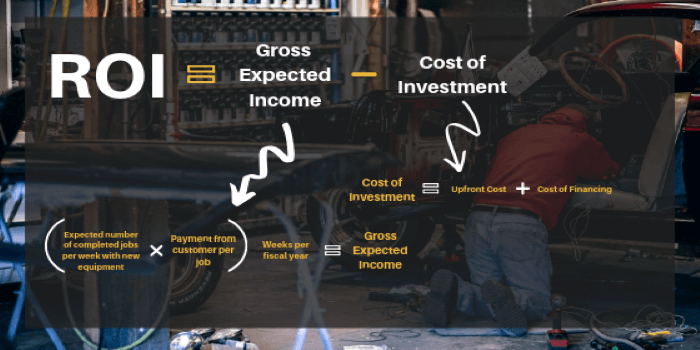As a business owner you should always be thinking about your main job, “how can I ensure the company is making money”. Revenue growth allows for site expansion, expansion of staff and capturing larger groups of customers. Trying to decide where you will invest money into the business to see the greatest return on your investment can be tricky. Here are the top 4 investments to make in your auto-repair business to see the greatest return.
- Your Customers
- Your Team
- Your Space
- Your Tech and Equipment
Your Customers
Positioning your business and the customer together to find the issue with the car and treating your customers the way you want to be treated has shown a retention rate over 90%. Word of mouth referrals can make or break your business and potentially save you marketing dollars. Tracking each customer and their needs has allowed Casey McGowan’s shop to grow year after year and eclipse $2.5 million in revenue during the 2017 fiscal year. You should know your customers as well as you can, not only so they tell all their friends about your business but also, so you know how much they are willing to pay for services.
When investing in equipment you’ll want to calculate how much you can spend or what your Return on Asset will be. To do this, you need to know what each service will be charged and how often your customers will come in to get that service. If you have just started your business or are trying to grow your customer base here is some consumer information you should know:
Older car owners are 2x more likely to expect to pay over $1,000 at a repair shop but also are more likely to say yes to services like:
- Air Filter change
- Oil Filter Replacement
- Using a Fuel Additive
- Changing a Spark Plug
- Using a Premium oil
- Increasing the frequency of Oil Changes
Millennial Car Owners are more likely to come to a shop for services like:
- Tire rotation/balance
- Brake Service
- Tire Replacements
- Car Wash & Detailing
- Tire Alignment
- Wiper Blade Installation
- Heating/Cooling Services
People are seeking expertise in whatever it is that you do when they are searching for a shop to take their vehicle to. Kurt Krans’ shop focuses on European Auto and keeping a clean, organized shop is a big part of how Kurt and Casey McGowan ensure customers feel right at home. The latest consumer trends in the after-market car industry reports people are keeping their cars longer. They need to trust that you won’t take advantage of their choice to come to you for their auto-repair needs.
Your Team
Firstly…
Why is it a return on your investment to invest in your employees? Let’s look at something called an opportunity cost. Opportunity cost is the loss of potential gain from other alternatives when one alternative is chosen. For an Auto-repair business, the opportunity cost for not training, promoting or putting an investment of time into existing employees can be thousands of dollars lost and spent on finding a replacement. The median cost of turnover percentage ACROSS all industries is 21% of the annual salary. Based on the average pay for an auto service technician/mechanic in the US (via pay scale), you could be looking at a cost of turnover of about $10,000.
Second…
You should know your technician’s labor rate so that you know how much training they may need. BJ. Lee, a coach for the Institute for Automotive Business Excellence states that, “One of the best productivity and efficiency metrics is effective labor rate. This tells you how much that technician is actually costing your business: (Actual hours worked X loaded hourly pay)/hours billed. This number balances a technician’s efficiency against this or her loaded pay. A tech should be making you money, not losing it.” So if you find your technicians labor rate is too high, it is time to have a conversation about what they think would help them do their job more efficiently.
Training
Types of Training:
- Management Training
- Customer Service Training
- Service Advisory Training
- Auto-tech Training
- Equipment Training
- Technology Training
- Collision Repair Training
- Certification Programs
A study done by I-CAR revealed improvements on key performance metrics after just 6 months compared to the previous year. The most staggering result? Reworks and come-backs were reduced by 80%! If your team didn’t have to do the job twice, how many more tickets could you schedule into the work day?
Outlining your employee’s growth goals and supporting them with proper training will increase their productivity rate at your business and ensure that your equipment is being used properly to get the highest return of investment possible.
According to Bob Cooper from Elite Worldwide there are 7 big reasons Auto-repair shops fail. In reasons #1, 3, and 4, having the right people and training the right people are key indicators of a pass/fail auto repair business. In reference to investing, Bob says, “Whenever I look at the financial statements of a struggling or failed auto repair shop, one thing is almost certain: There is a glaring absence of any investment in their own education and in the training of their staff.”
You can draw a superstar staff from many different sources. No matter how superstar your staff may be on arrival, continued training is mandatory to stay current in a competitive market. Training and improving your staff doesn’t have to be something you save for before investing in. You can use business financing for other investments like equipment. To ensure you have the right people, you can look to local education centers and host students for some “real world” experience and you may find someone worth hiring in the process. Investing in yourself and your team is where you can see major returns and saving over time.
Your Process
Elements of a Good Process
- Goal setting and mission setting
- Scheduling each job
- System for: calls, customer management, job management, inspection, recommending and selling services, performing services, customer follow-up
- Having a team for support
Alex’s Autohaus-Each advisor gets one support person (getting driver to return parts, sending postcards to customers, reminding customers of appointments). For his business it is more cost effective as the service advisor is now not wasting time on admin tasks. Each week technicians and service advisors have a staff meeting where they are held accountable for their work. They can look at each job since everything is tracked in their CRM system and say, “I was able to complete this much work this week” or “I was only able to produce this much work this week and this is why”.
At European AutoSpecialist, every job is scheduled. The shop owner has control over what jobs are done when based on the time it takes the tech assigned to complete that job. This tech time is factored after the 5th or 6th time a technician has completed that job to allow for a learning curve. They can also order parts in advance and plan out each day the day prior to ensure that goals are clear.
Communication must be ongoing and clear. As the small business owner, delegation should be a bit part of what you are communicating to your staff.
Set the goals, develop the plan, and hire and train good employees and monitor and check
You shouldn’t be spending your time micro-managing the way the place is swept. Your job is to make sure your business is profitable. Another part of communication is feedback. Some types of feedback that is important is:
-Thanking your employees when they do a job well
-Making meetings to track progress to adjust tech time, goals or the process
-Keeping an open mind when listening to what others are saying
Your Tech and Equipment
Could you imagine trying to fix a radiator with a hammer? Could you imagine even beginning a technological repair without the proper diagnostic tool? Your team would be working for hours causing frustration for them, backups and losing customers.
You might need to expand- if your days are packed full, 5 days a week is causing a 1-2week appointment delay and doing all the jobs yourself is driving customers to other shops, consider a bigger place. If you need a bigger place now and you can’t get funding from the bank, you can research short-term small business financing.
You might need to replace your tech if- your equipment doesn’t have any updates available for this year. Technical programs (whether it is Customer Management, Shop Management or Computer Systems Diagnostic software) are updated at least each year. The last thing you want is your staff using antiquated programs to manage your business with you. Furthermore, your technicians cannot do a computer repair in a 2018-year vehicle with 2016 year equipment. It will end up wasting time and driving productivity down all while upsetting your waiting customers.
You might need to investigate purchasing new industrial equipment if- your current equipment is falling apart. You know those signs: Multiple repairs needed at a higher frequency, longer job times due to malfunctioning equipment, frustrations expressed from your team when using equipment, etc. Sometimes all you must do to see if your equipment needs upgrading is open the window and listen to the conversations in your shop.
Purchasing big-ticket tools is a decision that often is postponed when the cash flow for businesses is low or there is no savings. You should always save for a rainy day and you can’t always predict when productivity will come to a screeching halt if a car lift malfunctions indefinitely. Luckily there are a lot of financing options for businesses but if you cannot get a loan from a bank, investigate Reliant Funding. A short-term capital account may be the perfect fit for you.
So how do you calculate ROI on Equipment?
Let’s use a simple example. When you decide to buy an annual pass or subscription vs. purchasing something “a-la-carte”. The first thought is “How many times do I have to attend or use this for it to pay for itself?” This is sometimes referred to as the Pay Back Period of an investment.
Equipment paying for itself also involves knowledge of how much you will charge for each job using the equipment minus the cost of labor for the job. You should also consider the length of time to complete the job using the new equipment vs. the old. If you find that with new equipment, you can increase productivity of A/C jobs by 50% and that is the #1 service your customers come to your shop for-time to buy new equipment.
When calculating expenses on making this purchase, reach out to the manufacturer for the numbers they can help you with. Many manufacturers help with electricity costs, training, cost of installation, and shipping costs. If you are obtaining traditional funding to make this purchase- integrate your aggregated interest rate over the term of the loan. This number for short-term funding ya be a daily cost versus an interest rate. This cost of financing will depend on what type of financing you get and not all types of funding are created equally.
After all these aspects of investment and the return of are complete, you can do some math. Here is a basic ROI equation:

There is also a great resource for more calculations here.
Once you find your ROI on whatever capital plan you have expected to make, you can now create how you will implement that plan with goals, metrics and a great team meeting. If you are finding you need funding to reach the return amount you are striving for, feel free to give Reliant Funding a call to have the conversation today.






